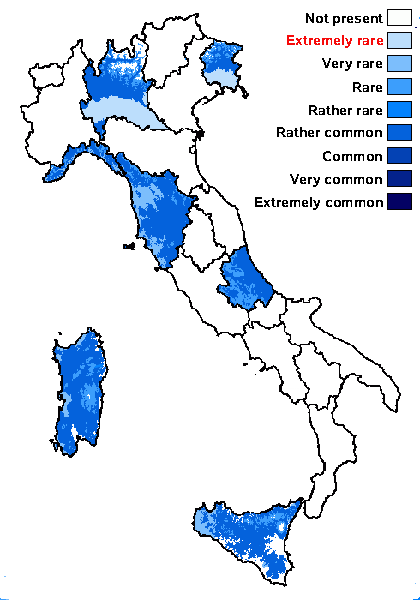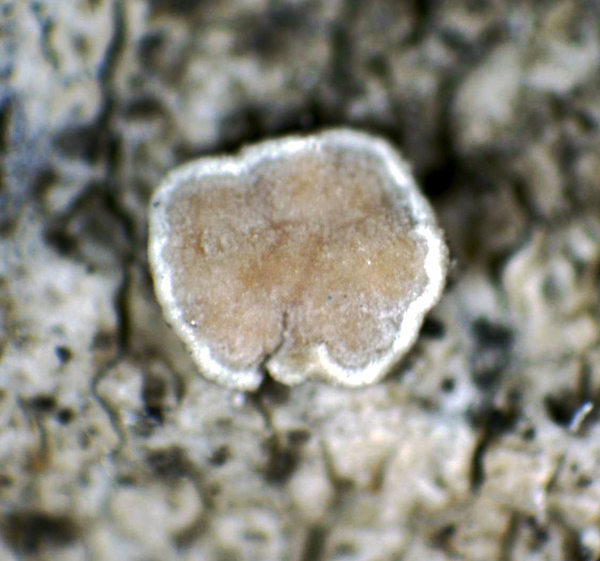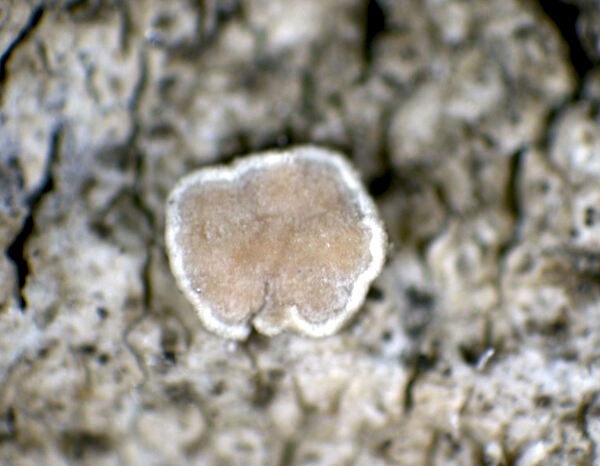Lecanoropsis saligna var. sarcopis (Ach.) ined.
. Basionym: Parmelia varia var. sarcopis Ach. - Meth. Lich. Suppl.: 40, 1803.
Synonyms: Lecanora effusa var. sarcopis (Ach.) Th. Fr.; Lecanora minuta Colmeiro?; Lecanora saligna var. sarcopis (Ach.) Tomin; Lecanora sarcopis (Ach.) Ach.; Lecanoropsis sarcopis (Ach.) M. Choisy nom. illegit.
Distribution: N - Frl, Lomb, Lig (Valcuvia & al. 2000). C - Tosc (Loppi & al. 1997c, 1999a, Laganà & al. 2002), Abr, Sar. S - Si (Merlo 1993).
Description: Thallus crustose, ecorticate, granulose, whitish to yellowish green, more commonly grey or beige to grey-brown, without a distinct prothallus. Apothecia lecanorine, round or angular by mutual compression, often crowded, sessile with a weakly constricted base, (0.3-)0.4-0.7(-0.9) mm across, with a pale ochre to red-brown or dark brown, flat to slightly convex disc and a weakly to strongly prominent, and a prominent, persistent, smooth to slightly crenulate thalline margin which is often slightly paler and more yellowish than thallus. Thalline exciple corticate, the cortex (6-)10-23(-39) µm wide laterally, (18-)19-30(-45) µm wide at base; proper exciple colourless to faintly brown, (8-)15-60(-70) μm wide; epithecium reddish brown to brown, with granules soluble in K, reacting N+ orange-red; hymenium colourless or with orange-brown granular patches, (35-)40-65(-75) µm high; paraphyses sparingly branched and anastomosing, 1.5-2 µm thick at mid-level, the apical cells 2-5 µm wide, the apical gel sheath 3-6 μm wide; hypothecium colourless or pale yellowish brown, (35-)65-160(-220) µm high. Asci 8-spored, clavate, very thin-walled, with a K/I+ blue, tall tholus penetrated by a faintly amyloid apical cushion, the wall K/I-, surrounded by a blue outer layer, Lecanora-type. Ascospores 1-celled, hyaline, narrowly ellipsoid, often slightly bent or deformed, (6.5-)8-11(-13.5) x (3-)4-6(-7.5) µm. Pycnidia semi-immersed to immersed, with a pale brown wall, colourless to pigmented in upper part. Conidia of three types: 1) broadly fusiform to curved macroconidia measuring 7-8 x c. 2.5 μm, produced into 60-110 µm wide macropycnidia (the most common); 2) slightly curved leptoconidia measuring 8-11 x 1-1.5 µm; 3) microconidia measuring 7.5-10.5 x 0.9-1.2 µm. Photobiont chlorococcoid. Spot tests: thallus K-, C-, KC- or KC+ pale yellow, P-, UV-. Chemistry: thallus with isousnic acid and variable amounts of usnic acid; apothecia with the Superba-brown pigment. Note: a mainly temperate lichen found on the acid bark of isolated deciduous trees; closely related to var. L. saligna and most probably not worthy of taxonomic recognition.
Growth form: Crustose
Substrata: bark
Photobiont: green algae other than Trentepohlia
Reproductive strategy: mainly sexual
Commonnes-rarity: (info)
Alpine belt: absent
Subalpine belt: absent
Oromediterranean belt: absent
Montane belt: rare
Submediterranean belt: rather common
Padanian area: extremely rare
Humid submediterranean belt: rather common
Humid mediterranean belt: very rare
Dry mediterranean belt: absent

Predictive model
Herbarium samples
Growth form: Crustose
Substrata: bark
Photobiont: green algae other than Trentepohlia
Reproductive strategy: mainly sexual
Commonnes-rarity: (info)
Alpine belt: absent
Subalpine belt: absent
Oromediterranean belt: absent
Montane belt: rare
Submediterranean belt: rather common
Padanian area: extremely rare
Humid submediterranean belt: rather common
Humid mediterranean belt: very rare
Dry mediterranean belt: absent

Predictive model
| Herbarium samples |
 DOLICHENS
DOLICHENS




